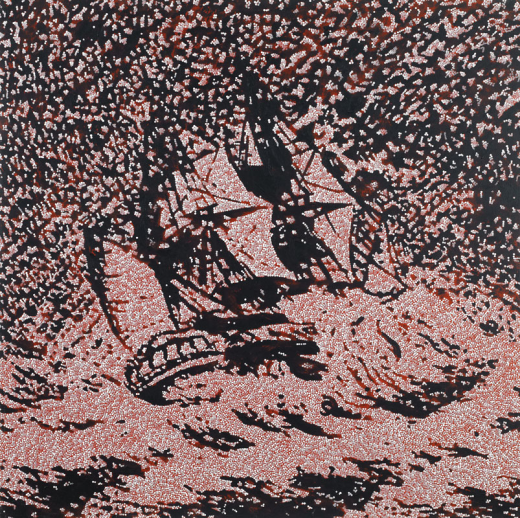Gordon Bennett
born 1955
AUSTRALIAN ICON (1989)
$50,000–70,000
PROPERTY FROM A DISTINGUISHED PRIVATE COLLECTION, MELBOURNE
Gordon Bennett
born 1955
AUSTRALIAN ICON (1989)
synthetic polymer paint on canvas
150.5 X 150.5CM
- Lot Sold $50,000 (Hammer Price)
- $60,000 (Hammer Price with Buyer's Premium)
Provenance
Lauraine Diggins Fine Art, Melbourne
Private Collection, Melbourne
Aboriginal Art
, Sotheby's Australia, Sydney, 28 July 2003, lot 191, illustrated
Private Collection, Melbourne
Depending on how far you stand from Australian Icon (notes on perception no. 6)
you will be compelled to read two diametrically opposed signs of identity. Look at the painting across the gallery and be struck by an image of a sailing ship, tossed in a tempestuous sea. Alternately, open your eyes near the work and you are submerged in a field of dots instantly placing you in the continents 'Red Centre', so familiar are the dotted representations of central desert landscapes
Like Edgar Rubin's famous figure-ground-vase-face, the power of Australian Icon
comes from its binary purity. Look at either the ship or the field of dots and you feel you have a grip on reality, but move backwards or forwards and the painting's paired illusions invert. It is this slippage that persists as the subject of this deceptively simple work.
Bennett created the Australian Icon
series at a tipping point in the nation's public history.
In 1988 Australia was in the grip of the Bicentennial celebrations that saw various reenactments of one sort or another, including the 'tall ship' event that saw a group of sailing vessels set out to retrace the journey of the 'first (European) fleet to Australia'. Aboriginal groups declared it to be a year of mourning. I began to use illustrations out of old social studies and history text books by way of critical intervention in the seamless flow of images that I plainly saw was designed to reinforce the popular myth and 'common sense' perspective of an Australian colonial identity and 'pop' history. I had in mind to create fields of disturbance which would necessitate re-reading the image, and the mythology.' (1)
Bennett has stated that it is unimportant which particular ship is depicted, but concedes that 'in the context of the Bicentennial, a ship is very likely to be interpreted in relation to the 'first (European) fleet', or even Captain Cook's 'Endeavor''. (2) Bennett was not alone in his urge to re-paint history in 1988. The Arnhem Land artist Paddy Fordham Wainburranga also used the image of a ship as the vector of invasion. Wainburranga's Too many Captain Cooks was created in the same year he delivered 23 of the 200 painted, hollow, log coffins to be installed permanently in the National Gallery of Australia, each standing for the loss of Aboriginal lives since European colonization.
In 2012, almost a quarter of a century after the Bicentennial, Bennett's satirical take is likely to '\x85 evoke the romantic narratives of adventure, danger, exploration and discovery that form a major part of the mythology that informs 'mainstream' identity'. Australian Icon
has not lost any of its potency with the passage of time. As the curator and academic Ian McLean has pointed out, Bennett parodies the metaphors of enlightenment. (3)
There is a double entendre in Bennett's deployment of the dotted field, '\x85 images I select exist between the pages of art books and history. Their unifying factor is the dot screen of their photo-mechanical reproduction and their iconographical relationships as points of reference, or 'sites', on a Western cultural perceptual grid.' (4)
Australian Icon
was painted at the moment when the art of the 'dot and circle' had only recently received widespread national recognition; we had not yet grown weary of the use of Central Australian motifs applied to everything from jumbo jets to boomerangs made in Bali. Bennett's painstaking application of the dotted field was a reenactment of the process, developed a decade earlier by a handful of Papunya Tula Artists whereby several dots are made in regular succession by loaded brush, each producing a mark of slightly decreased opacity. The nuanced surface is created by focused effort on the act of painting, 'Each dot, gently and carefully'. (5) Step away however and those patterns become the serried traces of gale, ripping across the surface of the sea, even as breakers threaten to engulf the ship, and its colonial cargo.
Bennett's Australian Icon
erased the divide between 'Western' and 'Aboriginal' art, elegantly identifying cultural influences that flow both ways. From that moment it was apparent creative minds on either side of the untidy frontier were considering the complexities and contradictions of living in a post-modern world.
John Kean
(1) Gordon Bennett, The Manifest Toe, in Ian McLean, Gordon Bennett, The Art of Gordon Bennett
, Craftsman House, New South Wales, 1996, p.34-35
(2) Ibid
, p. 41
(3) Ian McLean in Ian McLean, Gordon Bennett, The Art of Gordon Bennett
, Craftsman House, New South Wales, 1996, p.74
(4) op. cit.
p.43
(5) Michael Nelson Tjakamarra in Vivien Johnson, Lives of the Papunya Tula Artists
, IAD Press, Alice Springs, 2008, p.205
|
Geoffrey SmithChairman Australian & International Art |
Fiona HaywardSenior Specialist Australian & International Art |
|
Dr David HansenSenior Researcher | Specialist Australian & International Art |
Brett BallardSpecialist Australian & International Art |
|
Harley YoungFacilities & Operations Manager | Australian & International Art |






